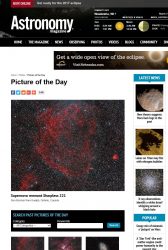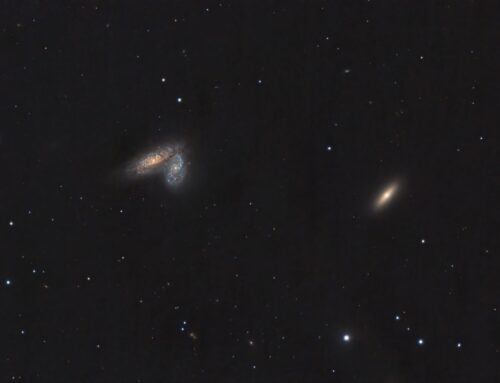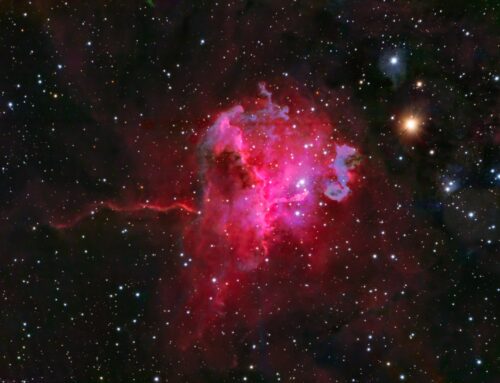Sharpless 221, Supernova Remnant
 Click image for full size version
Click image for full size version
March 7, 2017. Astronomy Magazine Picture of the Day, March 21, 2017
 Sharpless 221 (Sh2-221) is a huge supernova remnant in Auriga, The Charioteer, not far from the bright star Capella. It has about four times the Moon’s diameter on the sky, and lies about 2,600 light years away. The structures visible in this image are dominated by emissions from hydrogen (red) and oxygen (teal). The oxygen seems to form an envelope around the object. There are some nice teal coloured details at lower left and upper right that are reminiscent of the much brighter and more famous Veil Nebula. This object is extremely faint, and may be the most challenging object I have imaged.
Sharpless 221 (Sh2-221) is a huge supernova remnant in Auriga, The Charioteer, not far from the bright star Capella. It has about four times the Moon’s diameter on the sky, and lies about 2,600 light years away. The structures visible in this image are dominated by emissions from hydrogen (red) and oxygen (teal). The oxygen seems to form an envelope around the object. There are some nice teal coloured details at lower left and upper right that are reminiscent of the much brighter and more famous Veil Nebula. This object is extremely faint, and may be the most challenging object I have imaged.
Other objects in this field include Sh2-217, on its own at lower right, and smaller Sh2-219 tucked up against the bottom right of Sh2-221. The dark nebula Barnard 25 is at lower left, beneath the two bright stars. The field is littered with faint galaxies, but they are extremely difficult to see in the crowded star field. I could only see a few of them even with the help of an annotated image.
If I were in charge of naming things in the sky, I’d call this the Human Heart Nebula. Almost everyone who I showed it to has said it looks like a human heart. In fact, maybe even more than the Heart Nebula. It could also be called the “Barely There Nebula,” being so dim.
The processing description below doesn’t give any sense of how many blind alleys I went down while processing this data. My typical workflow barely revealed almost nothing. I experimented to find ways to make the nebula more visible, while managing the noise without losing detail. My new knowledge makes me want to see what I can tease out of my image data for other dim objects. More projects for cloudy nights…
Tekkies:
Moravian G3-16200 EC camera (on loan from O’Telescope), Optolong Ha, O3, R, G and B filters, Takahashi FSQ-106 ED IV at f/3.6, Paramount MX, QHY5 guide camera, 175mm f.l. guide scope. Acquisition with the SkyX, focused with FocusMax. All pre-processing and processing in PixInsight. Acquired from my SkyShed in Guelph. No moon for Ha and O3, crescent moon for RGB, average transparency and seeing.
5x10m R, G and B; 10x20m Ha and 8x20m O3 unbinned frames (total=8hr30m).
NB-RGB Creation
Creation and cleanup: R, G, B, Ha and O3 masters were cropped and processed separately with DBE. The O3 channel was processed using my method to reduce halos around bright stars. R, G and B were combined to make an RGB image which was processed with BackgroundNeutralization and ColorCalibration.
Linear Noise Reduction: MultiscaleLinearTransform was used to reduce noise in the background areas of the RGB, O3 and Ha images. Layer settings for threshold and strength: Layer 1: 3.0, 0.5 Layer 2: 2.0, 0.35 Layer 3: 1.0, 0.2 Layer 4: 0.5, 0.1
Stretching: HistogramTransformation was applied to the RGB, Ha and O3 masters using the Autostretch settings for each.
Combining Ha, O3 and RGB data: The NBRGBCombination script was run with default settings using Ha for red narrowband and O3 for green and blue.
Synthetic Luminance:
Creation and cleanup of SynthL: The stretched Ha, O3 and the luminance from the RGB master were combined using the ImageIntegration tool (average, additive with scaling, noise evaluation, iterative K-sigma / biweight midvariance, no pixel rejection).
Noise Reduction and Re-Stretch: TGVDenoise was applied in Lab mode with 300 iterations with a range mask used to protect high signal areas. This was followed by a HistogramTransformation to raise the black point (but with no clipping).
Combining SynthL with NB-RGB:
The processed SynthL was applied to the NB-RGB image using ChannelCombination in Lab mode with default settings.
Additional Processing
Final Steps: Background, nebula and star brightness, contrast and saturation were adjusted in several iterations using Curves with masks as required. SCNR was applied to the lower right corner to correct a green cast. MultiscaleLinearTransform was used to sharpen the highest signal areas using a mask to protect stars and low signal areas.
Image scale is 3.2 arcsec per pixel for this camera / telescope combination.






Leave A Comment